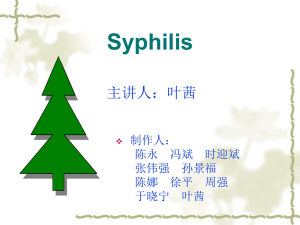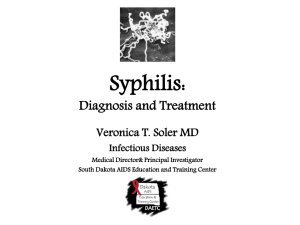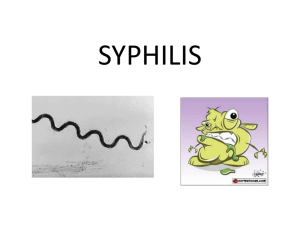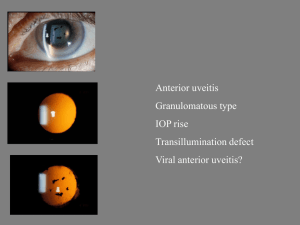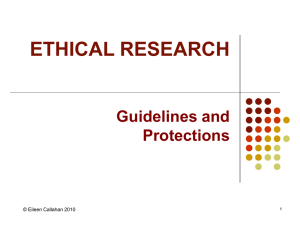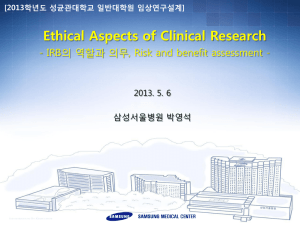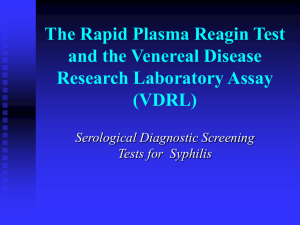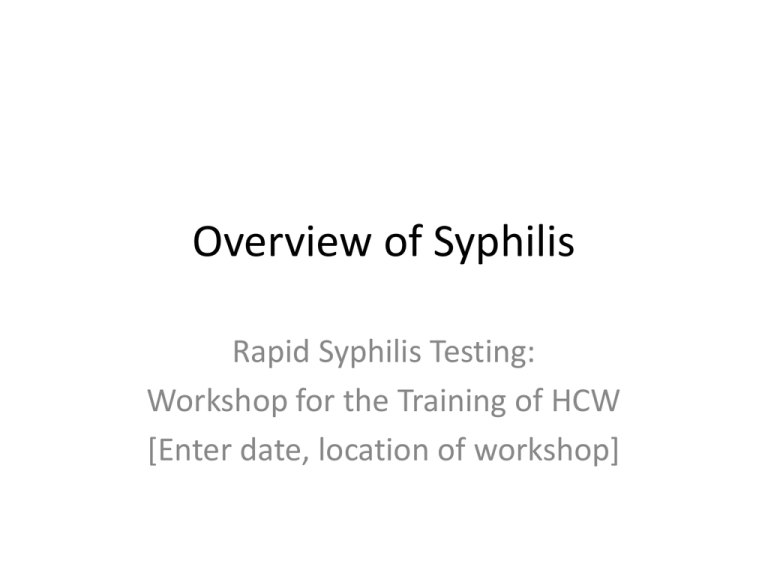
Overview of Syphilis
Rapid Syphilis Testing:
Workshop for the Training of HCW
[Enter date, location of workshop]
Learning Objectives
By the end of this module, participants should:
1. Understand of the global epidemiology of
syphilis and congenital syphilis
2. Describe the stages of syphilis infection
3. Clinically identify the signs of infection
4. Understand syphilis transmission and the risk
during pregnancy
Overview of Syphilis
• Syphilis is a sexually transmitted infection
• Caused by a bacteria, Treponema pallidum
• Initial infection causes a genital ulceration
– Raised painless lesion
• Genital ulcer disease can be caused by other
organisms as well
– Herpes simplex, Haemophilis ducreyi (chancroid)
Epidemiology
• Syphilis is a major public health problem
• An estimated 12 million new cases of syphilis occur
worldwide each year
• The majority of infections occur in the developing
world including Latin-America, sub-Saharan Africa and
Southeast Asia
• Untreated syphilis in pregnancy is associated with
spontaneous abortion, stillbirth, perinatal death,
premature delivery, low birth weight, or congenital
syphilis
WHO estimates 12 million new cases of syphilis
occur worldwide each year
100,000
140,000
100,000
240,000
370,000
4M
3M
4M
10,000
Syphilis Prevalence
• In [Sub-Saharan Africa/ Latin America/ SouthEast Asia], the prevalence of syphilis infection
ranges from [lowest estimate]-[highest
estimate]%
• In [Enter name of country], the prevalence of
syphilis is [enter national prevalence]%
Modes of Transmission
• Syphilis is transmitted through
– Contact with the genital ulcer
– Mother to child (vertical transmission) during
pregnancy
– Blood transfusion
Clinical Presentation
• Syphilis presents in multiple stages
– Primary, secondary, early latent, late latent and
tertiary
• Primary syphilis presents as a painless ulcer
– Mainly on external genitals, vagina, anus, or
rectum
• In women, the ulcer may be deep in the vagina and go
unnoticed
– Can also be on fingers, lips, or mouth
Primary Syphilis
• Primary syphilis occurs 3 weeks after infection (990 days)
• Primary syphilis is characterized by a painless,
indurated ulcer (or chancre)
• After 1-5 weeks, the ulcer spontaneously resolves
without treatment
• This stage is highly infectious
Secondary syphilis
• The bacteria have spread to all organs and body
fluids
• Symptoms develop 1-5 weeks after the ulcer
• Characterized by a generalized rash
• Symptoms spontaneously resolve after 2-6 weeks
• This stage is also highly infectious
Early Latent Syphilis
• Asymptomatic
• Occurs <1 after infection
• Less infectious than primary and secondary
syphilis
• Vertical transmission can still occur
Late latent syphilis
• Occurs 2 years after initial infection and may
last the patient’s lifetime
• Asymptomatic
• Lower risk of transmission during this stage
than earlier stages of infection
Tertiary Syphilis
• Occurs anytime after secondary syphilis and may not
occur at all
• Result of widespread infection during secondary
syphilis
• Symptoms include gumma (lesions) of the skin,
muscles, eyes, bones
• Also includes cardiovascular syphilis and neurosyphilis
Congenital Syphilis
• Causes stillbith, miscarriage, and preterm labour
• Babies born to syphilis positive mothers may have
low-birthweight, abnormal liver or spleen
development, anemia, jaundice, lesions on the
palms and soles, or neurological problems
• Only half of newborns infected with syphilis can
be clinically identified at birth
Infectivity of Syphilis
1° > 2° > Early Latent > Late Latent & 3°
Primary Ulcer
Rash on palms & soles
Asymptomatic, <2 years
Asymptomatic, >2 years
Gumma, Neurosyphilis,
Cardiovascular syphilis
The Course of Untreated Syphilis
66 weeks
weeks
to
to
66 months
months
Many
Many years
years
to
a
lifetime
to a lifetime
Infection
Infection
Approx.
Approx.
18
18 months
months
Primary
(Chancre)
Secondary
(Rash)
Latent Syphilis
(No signs of disease)
Tertiary
Benign gummatous
Cardio-vascular syphilis
Neurosyphilis
Incubation period
9 – 90 days
1-2 years
Many years
to a lifetime
Early Syphilis
Late Syphilis
Conclusions
• Syphilis is a major health concern and causes
stillbirth, low-birthweight babies and
congenital syphilis
• Syphilis is transmitted through contact with a
genital ulcer, through sexual intercourse,
vertically from mother to baby during
pregnancy or through blood transfusions
• Syphilis has multiple stages
Questions for Participants
• Have you ever seen a case of syphilis?
– Was it primary, secondary or tertiary syphilis?
• Have you ever seen a baby with congenital
syphilis?
References
WHO. The elimination of congenital syphilis: Rationale and
strategy for action. 2007. http://www.who.int/reproductivehealth/publications/congenital_syphilis/strategy_congenitalsy
philis.pdf. Accessed January 24, 2008
Aiken CG. The causes of perinatal mortality in Bulawayo,
Zimbabwe. Central African Journal of Medicine 1992; 38: 263281
Syphilis Testing Technologies
Rapid Syphilis Testing:
Workshop for the Training of HCW
[Enter date, location of workshop]
Learning Objectives
By the end of this module, participants should be
able to:
1. Describe the difference between a test that
detects bacteria and a test that detects
antibodies.
2. Understand the definitions of antigen and
antibody.
3. Describe the main characteristics of treponemal
and non-treponemal tests.
4. Describe the characteristics and benefits of
rapid diagnostic tests.
Syphilis diagnostics
Diagnosis of syphilis infection is based on
detection of:
1. Treponema pallidum bacteria
1. Antibodies
Detection of Bacteria
The following diagnostic tests diagnose syphilis
infection based on the detection of the
Treponema pallidum bacteria:
• Microscopy
• Dark field
• Fluorescent
The Immune Response
• Antigen (Ag)
– Is a substance recognized by the body or immune
system as foreign
– It may be the whole organism or part of it (protein,
lipids, ect.)
– An antibody is produced by the immune system in
response to the detection of an antigen
• Antibody (Ab)
– A protein produced in response to an Ag
– The antibody will attack the Ag as part of the immune
response
Syphilis Antibody Response
Two types of antibodies are produced during a
syphilis infection
1. Treponemal Antibodies
1. These are produced against an Ag specific to syphilis
2. Non-treponemal Antibodies
1. These are produced against a non-specific Ag,
reagin/ cardiolipin
2. Reagin/ Cardiolipin is also produced when tissue is
damaged during infection (Tb, malaria), autoimmune conditions (rheumatoid arthritis) or
pregnancy
Syphilis Antibody Response
FTA-Abs
100
%
TPHA
80%
60%
untreated
IgM*
40%
VDRL /RPR
20%
treated
2
4
6
8
10
12
2
10
time (years)
Time (weeks)
primary
lesion
Clinical
stages of
syphilis
primary
secondary
lesion
secondary
latent
tertiary
Detection of the Antibody
• Serological tests for syphilis diagnosis detect
either the treponemal or non-treponemal Ab
• Treponemal tests detect the antibody specific
to syphilis
• Non-treponemal tests detect the reagin/
cardiolipin antibody that is produced during
syphilis infection but is not specific to syphilis
Types of Treponemal Tests
1.
2.
3.
4.
5.
6.
Agglutination Assays (TPPA, TPHA)
Fluorescent Assays
Treponema pallidum Immobilisation (TPI) test
ELISA Assays
Western Blot
Chromatographic tests (POC)
Treponemal Tests
• Detect antibodies specific to T. pallidum antigens
• They become positive early in infection
• Can be used to:
– Confirm a clinical diagnosis, OR
– Confirm positive result for non-treponemal test
• Remain positive for many years, even after successful
treatment
• Detect life-time syphilis exposure
Reactivity of Treponemal Serological Tests by Stage of Syphilis
and Influence of Successful Treatment
Treponemal Tests
• Most are limited to research laboratories
– POC tests are the exception
• Samples have to be transported to established labs
• Results are not available for several days or weeks
• Individuals may not return for results
– Resources are wasted
– Positive may not be treated leading to adverse pregnancy
outcomes or onward transmission
How to Perform TPPA/ TPHA
•
•
•
•
•
Add sample diluent to wells 1-4
Add serum sample to well number 1
Mix and transfer to well number 2
Repeat this process to well number 4
Mix and discard same volume transferred from
well 3
• Add unsensitized RBCs/ Gelatin particles to well
number 3
• Add sensitized particles/ RBs to well 4
• Read results in a light box after incubation
Fluorescent Treponemal Antibody Test
Simple Treponemal Tests
Rapid Syphilis Tests (RST):
• Are simple to perform
• Can be used at primary health centres, at the point of care
• Give results in less than 30 minutes
• Use whole blood, collected from a finger prick
• Enable treatment to be give the same day as testing
Simple Treponemal Tests
Like all treponemal tests, RSTs:
• Detect antibodies specific to T. pallidum
• Can be used early to detect infection
• Remain positive even after successful
treatment
Simple Treponemal Tests
• Important for control programmes
• Use whole blood, serum or plasma
• Can be integrated into other programmes (VCT, PMTCT,
STD, ANC)
• Have high sensitivity (85-98%)
– This is a measure of the ability of a test to detect infection
• Have high specificity (93-98%)
– This is a measure of the ability of a test to exclude infection
Format of RST
• Strips
• Cassettes (ex. SD Bioline)
Performing RST
• Follow the manufacturer’s instructions or a
national SOP
• SOP or Standard Operating Procedure provides
detailed instructions on how to perform the test
• NOTE: Written SOPs should always be available at
each testing site, and must always be followed
when performing testing
RST Procedure
•
Prepare the testing area and put on gloves and gown/ apron
•
Remove the test cassette from the foil pouch
•
Place it on a flat surface and label it with the client/ patient number
•
Add patient specimen (serum/ whole blood/ plasma) to sample well S
•
Add diluent buffer to sample well S
•
Read the results after the specified time
•
Enter results on record form/ register
•
Dispose of all materials in biohazard waste/ sharps container
Advantages of Rapid Tests
•
•
•
•
•
•
•
•
Do not require equipment
Simple and rapid
Use whole blood, serum or plasma
Require minimal technical skills
Can be performed at the Point of Care (POC)
Increase access to testing
Increase coverage of testing and treatment
Results are easy to interpret
RPR vs. Rapid Tests
RPR (non-treponemal test)
Rapid Syphilis Test (treponemal test)
Can be used to distinguish active from
past treated infection
Cannot distinguish active infection from
past treated infection
Test of cure
Measures lifetime exposure to syphilis
Serum/ plasma
Whole blood/ serum/ plasma
Needs laboratory facility & trained
personnel
Can be done in primary health care
settings
Test only takes 8 minutes but patients
often need to return for results and
treatment
Results in less than 30 minutes and
treatment can be given at the same visit
Interpretation of results requires a high
degree of training and experience
Results are simple to interpret
Reagent needs refrigeration
Test and reagents can be transported and
stored at room temperature
False negative results due to prozone
effect and biological false positives
No prozone effect or biological false
positives
Interpretation of RST Results
• Unable to distinguish between active infection
and past treated infection
• A positive RST result indicates the client/
patient has been exposed to syphilis during
their lifetime
[REFER TO NATIONAL GUIDELINES FOR FURTHER
GUIDANCE ON CONFIRMATORY TESTING,
TESTING ALGORITHMS, AND TREATMENT
STRATEGIES]
Syphilis: Proposed Testing Algorithms
No RPR testing available:
RPR testing available:
Blood
Blood
RDT
RDT
+
+
positive
-/-
negative
-
RPR
+
negative
Re-test in 6 wks
treat
positive
treat
+
treat
Non-Treponemal Tests
• T.pallidum infection produces non-specific
antibodies (non-treponemal antibodies)
• These are detected by non-treponemal tests
(RPR, VDRL)
• Non-treponemal (reagin/ cardiolipin) antibodies
arise from:
– Lipoidal antigens that are the same on bacterial cells
and host cells
Types of Non-treponemal Tests
• Flocculation
– Antigen-antibody complex
– Ag-Ab complex remains suspended (visible)
– Ex. RPR, VDRL, TRUST
• Complement Fixation Test
– Wasserman reaction test
Rapid Plasma Reagin (RPR)
• Relatively simple
• Requires equipment and skill to perform and interpret
results
– Results are subjective
• Less sensitive than Treponemal tests in early syphilis
infection
• Tend to be negative during late syphilis
• After successful treatment, becomes negative (Test of
Cure)
• Prozone effect causes false negatives
• Other infections cause biological false positives
Rapid Plasma Reagin (RPR) Test
• Needs electricity for:
Sensitivity: 85-95%
Specificity: 95-98%
Cost/test = $ 0.2
• centrifuge
• shaker
• reagent storage
• Requires training
• Humid atmosphere
Reactivity of Non-treponemal Serological Tests by Stage of Syphilis
and Influence of Successful Treatment
Non-treponemal Tests
• Detect non-specific antibodies formed during
syphilis infection
• Examples:
– Rapid Plasma Reagin (RPR)
– Venereal Disease Research Laboratory (VDRL)
Use of Diagnostic Tools for the
Prevention and Control of Syphilis
Diagnosis
RPR
+
Screening
+
+*
+/-
+
Tx efficacy
+
-
-
-
Re-infection?
+
-
-
-
Surveillance
+
+
+
+
* can be used with whole blood
Rapid TPHA
+*
+
EIA
+
Non-treponemal Tests
• Detect non-specific antibodies formed during
syphilis infection
– cardio-lipin antigen
eg. Rapid Plasma Reagin (RPR)
eg. Venereal Disease Research Laboratory (VDRL)
Questions for Participants
• Have you ever performed a syphilis test and if
so, which one?
• Was it a treponemal or non-treponemal test?
• How user-friendly do you think it was?
Treatment of Syphilis
Rapid Syphilis Testing:
Workshop for the Training of HCW
[Enter date, location of workshop]
Learning Objectives
By the end of this module, participants should
be able to:
1. Describe the recommended and alternative treatment
and dosage for an adult with syphilis infection
2. Describe how to manage an infant born to a mother who
tested positive for syphilis during pregnancy
3. Describe how to manage the partner of a syphilis positive
individual
4. Describe the potential reactions to the recommended and
alternative treatment for syphilis
5. Describe the potential risks and adverse outcomes if
treatment is not administered
When Do You Treat A Patient?
• If a pregnant woman tests positive for syphilis
• If a patient at the STI clinic tests positive for
syphilis
• If a patient at the delivery ward tests positive
for syphilis
When Do You Treat A patient
How To Treat Syphilis
• Before treating a patient, it is important to
provide them with counseling
– Explain what a positive result means and the risk
of transmission to a partner or baby
– Explain the treatment options available and that
syphilis is a curable disease
– Obtain consent from the patient
Counseling
1. REVIEW Pre-test information
2. HELP the patient understand the meaning of the result
–
–
–
A positive result means you are infected with syphilis
Syphilis can be cured with antibiotics
Syphilis infection can harm your unborn baby
3. DISCUSS any immediate concerns and ANSWER any
questions
–
–
–
Having syphilis once does not mean you will not get it again
You can still be re-infected after successful treatment
You should not have sex until the syphilis sores are completely
healed
Counseling
4.
ENCOURAGE safer sex practices in preventing reinfection and/or
transmission
–
–
–
5.
ADVISE on telling partners
–
6.
Use condoms
Have long-term relationships where neither of you have other
partners
Limit your sex partners
You should tell all your sexual partners that your are positive for
syphilis and that they should go to a health clinic to be tested and
treated [REFER TO NATIONAL GUIDELINES]
FOLLOW-UP Services
–
–
–
You should be tested for HIV infection
You should come in to be tested again in XXX weeks [REFER TO
NATIONAL GUIDELINES]
You should have regular STI check-ups
Counseling
Counseling
How To Treat Syphilis
• The National Guidelines recommended
treatment for an adult testing positive for
syphilis is:
• [All patients with a positive test result should
be treated regardless of treatment history in a
previous pregnancy]
• IMPORTANT: Treatment should be given on
the SAME DAY as Testing
How to Manage Partners
• [REFER TO NATIONAL GUIDELINES FOR
PARTNER MANAGEMENT]
• DETAIL IF THE PARTNER IS TO BE TESTED AND
TREATED ONLY IF POSITIVE, OR
PRESUMPTIVELY TREATED AS A CONTACT
WITHOUT TESTING
How To Treat Syphilis
• REFER TO NATIONAL GUIDELINES FOR
ALTERNATIVE TREATMENT REGIMENS IF A
PATIENT IS ALLERGIC TO PENICILLIN
• DETAIL THE MEDICATION, DOSAGE, AND
DURATION OF THE ALTERNATIVE TREATMENT
REGIMEN AND METHOD OF ADMINISTRATION
(ORAL, IV, INJECTION)
How To Treat Syphilis
• Infants born to mothers who tested positive for
syphilis during pregnancy need to be treated
according to the National Guidelines
• REFER TO NATIONAL GUIDELINES
• DESCRIBE THE MEDICATION, DOSAGE, DURATION
OF REGIMEN, AND ADMINISTRATION (ORAL, IV,
INJECTION)
• DESCRIBE THE ALTERNATIVE MEDICATION,
DOSAGE, DURATION OF REGIMEN, AND
ADMINISTRATION (ORAL, IV, INJECTION)
Infants with Congenital Syphilis
• Infants born with the signs and symptoms of
Congenital Syphilis need to be treated
according to the National Guidelines
• DESCRIBE THE MEDICATION, DOSAGE,
DURATION OF REGIMEN, AND
ADMINISTRATION (ORAL, IV, INJECTION)
• DESCRIBE THE ALTERNATIVE MEDICATION,
DOSAGE, DURATION OF REGIMEN, AND
ADMINISTRATION (ORAL, IV, INJECTION)
Syphilis Treatment
Age Group
Recommended
regimen
Alternative
regimen
Adult syphilis
Adults (including
pregnant women)
Congenital syphilis
Infants born to
mothers who tested
positive for syphilis
Infants with signs and
symptoms of
congenital syphilis
Remarks
Penicillin Allergy: Anaphylactic Shock
• All patients must be asked for a history of
allergy to penicillin
• Clinical Features: sudden collapse,
hypotension, excessive sweating, thin pulse
• Differential Diagnosis: other causes of shock,
including bleeding and severe dehydration
Management of Anaphylactic Shock
•
•
•
•
Determine and remove the cause
Keep the patient warm
Secure the airway
Restore the BP
– lay the patient flat and raise his/her feet
REFER TO NATIONAL GUIDELINES FOR FURTHER
INFORMATION
Management of Anaphylactic Shock
• REFER TO NATIONAL GUIDELINES
• DESCRIBE THE MEDICATION, DOSAGE,
DURATION OF REGIMEN, AND
ADMINISTRATION (ORAL, IV, INJECTION)
• DESCRIBE THE ALTERNATIVE MEDICATION,
DOSAGE, DURATION OF REGIMEN, AND
ADMINISTRATION (ORAL, IV, INJECTION)
Questions for Participants
• Have you ever had to treat anaphylactic
shock? Can you describe how you identified
it? How did you manage it? What was the
outcome?
• In your experience, how do people react to
hearing that they have syphilis?
Integration of Services
Rapid Syphilis Testing:
Workshop for the Training of HCW
[Enter date, location of workshop]
Learning Objectives
At the end of this module, participants should
be able to:
1. Describe the current patient flow at their clinic
2. Describe when and where rapid syphilis testing
would take place
3. Provide three examples of how syphilis testing
could be integrated with other services
Integration
• Rapid syphilis testing will be introduced to
facilities already offering several testing
services
• Integrating services can reduce the work load
of HCW and make it easier to perform
multiple tests
• Other rapid testing services are ideal for RST
integration
Integration & Patient Flow
• Patient Flow describe how patients move
throughout the facility to receive services
• Each Facility will have it’s own unique patient
flow
• Integration of services will differ at each
facility according to its patient flow
ANC Clinic: Patient Flow
• Patient flow at an ANC clinic offering HIV rapid
testing services and no syphilis testing services
ANC Clinic: Patient Flow
• Patient flow at an ANC clinic offering HIV and
syphilis rapid testing services without
integration
ANC Patient Flow: Integrated
Approach
• Patient flow at an ANC clinic offering
integrated HIV rapid testing services and
syphilis testing services
Possibilities for Service Integration
• HIV PMTCT
• HIV PICT or VCT
• Rapid Malaria Testing
• Hb Testing
• Other diagnostic tests requiring a finger-prick of
blood draw
Integrated Patient Flow
• DESCRIBE WHAT INTEGRATION OF SERVICES
WILL OCCUR IN YOUR PROGRAMME
• DESCRIBE HOW SERVICES WILL BE
INTEGRATED IN YOUR PROGRAMME
Integrated Patient Flow
• CREATE A DIAGRAM SHOWING PATIENT FLOW
FOR THE SERVICES THAT WILL BE INTEGRATED
WITH RAPID SYPHILIS TESTING
• THIS SHOULD BE DONE IN THE SAME STYLE AS
ABOVE
• THE DIAGRAM SHOULD HIGHLIGHT WHERE
INTEGRATION IS GOING TO OCCUR IN THE
CLINIC
• INSERT DIAGRAM ON THIS SLIDE
Health Care Worker Responsibilities
• Continue to provide clients/ patients with a
high degree of care
• Continue to follow the SOPs for each test
procedure
• Continue to provide clients/ patients with
Possible Challenges
• Mixing up tests (forgetting which is which
during testing)
• Mixing up buffer reagents
• Incorrect entering of results in register
• Timing
Solutions
• Be well prepared for testing
• Have each SOP present on the testing bench
• If the test cassettes have a similar appearance, label them (ex.
“HIV” and “syph”)
• Keep the buffer reagents next to the test kit during test
• Have the register near the testing bench and carefully transfer
results
• Prepare both tests simultaneously and start the timer when the
buffer reagent is added to the first test
Questions for Participants
• What services does your facility currently
integrate?
• What opportunities are there for further
integration?
• In your experience, has integrating services
been beneficial for the health care provider?
For the client/ patient? Why?
Safety at the Testing Site
Rapid Syphilis Testing:
Workshop for the Training of HCW
[Enter date, location of workshop]
Learning Objectives
By the end of this module, participants should
be able to:
1. Define safety
2. Identify potential hazards associated with rapid syphilis
testing
3. Describe how to dispose of biohazardous materials
4. Describe the safety precautions which need to be
observed when testing for syphilis
Performance Objectives
By the end of this module, participants will be
able to:
1.
Adhere to personal health and safety practices
2.
Maintain a clean and organized workspace
3.
Disinfect and dispose of infectious materials
4.
Take appropriate actions following accidental exposure to
potentially infectious specimen
5.
Follow written safety procedures and keep proper safety records
What Is Safety?
Safety is the state of being safe and protected
from danger, harm, or infection
Why Is Safety Important?
• Coming in contact with human blood or blood
products is potentially hazardous
• Safety involves taking precautions to protect
yourself and the client against infection
• All specimens should be treated as potentially
hazardous
What Else Needs Protection?
• Other people who may come in contact with
testing by-products
• The testing materials
• The environment (from hazardous material)
Universal Precautions
Every specimen should be treated as though it is
infectious
Apply Safety Practices Throughout the
Testing Process
• Before Testing (Pre-analytical)
– Specimen collection
– Specimen preparation
– Specimen transport
• Testing (Analytical)
– Testing
• After Testing (Post-analytical)
– Disposal
Develop Personal Safe Work Habits
• Wash hands before and after testing
specimens
• Wear a fresh pair of gloves at a lab coat or
apron
• Dispose of contaminated
sharps and waste immediately
after use
Develop Personal Safe Work Habits
• Pipetting by mouth is strictly forbidden
• Never eat, drink or smoke at the test
• Do not keep food in the laboratory refrigerator
• Do not leak anything in the lab (ex. pen,
pencil)
Maintain Clean & Orderly Work Space
• Keep work areas clean and organized
• Disinfectant work surfaces daily
• Restrict or limit access to test area when working
• Keep supplies locked in a safe and secure area
• Keep emergency eye wash units in working order
and within expiry date
Take Precautions to Avoid Needle Stick
Injury
What can cause needle stick injury?
• Lack of concentration
• Inexperience
• Lack of concern for others
• Improper disposal of sharps
Dispose of Used Sharps in Special
Containers
Sharps
Do’s and Don’t of Waste Disposal
• DO NOT: break, bend, re-sheath or re-use
lancets, syringes or needles
• DO NOT: shake sharps containers to create
space
Do’s and Don’ts: Sharps and Waste
Containers
What’s wrong with this picture?
101
Never Place Needles or Sharps in
Office Waste Containers
102
Sharps Containers Must Be
Placed near workspace
Closed when not in use
Sealed when ¾ full
103
Do’s and Don’t of Waste Disposal
• DO NOT EVER place needles or sharps in office
waste containers
• DO: place sharps containers near workspace
• DO: close sharps containers when not in use
• DO: seal sharps containers when ¾ full
Policy for Handling Sharps
•
•
•
•
The user is responsible for disposal of sharps
Must dispose of sharps after each use
Must place sharps in sharps containers
Do not drop sharps on the floor or in the
office waste bin
• Place sharps container near your workspace
• Seal and remove when container is ¾ full
• Dispose of all waste appropriately
Incineration of Waste
• Incineration is burning of contaminated waste
to destroy and kill micro-organisms
• Incineration is:
– Effective against potential re-use
– Protects the environment and nearby
communities
– Must be supervised
Disinfect Work Areas
• Use an approved disinfectant (ex. JIK)
• Disinfectant:
– Kills germs and pathogens
– Keeps work surface clean
– Prevents cross-contamination
– Reduces risks of infection
In Case of a Spill or Splash
• Wear clean disposable gloves
• Immediately and thoroughly wash any skin splashed with
blood
• Large spills: Cover with paper towels and soak with 0.5% Jik
and allow to stand for at least 5 minutes
• Small spill: Wipe with paper towel soaked in 0.5% Jik
• Discard contaminated towels in infectious waste containers
In Case of an Accident
• What types of accidents can happen?
– Potential Injury (needle sticks, falls)
– Environmental (splashes, spills)
– Equipment damage
• What should you do?
– Report to your supervisor immediately
• Assess and take action
– Record using form
• Monitor situation
Action Plan for Implementing Safety
Practices
• Identify hazards
• Establish and implement safety policies and
procedures
• Conduct safety specific training
– Must be a priority
– Communication is key
• Perform regular audits or assessments
Safety Documentation
• Full safety requirements for testing blood/ serum specimens are
very detailed
• Any site performing testing should have a complete set of country
guidelines
• Every staff member should read and understand the safety manual
before being allowed to work
• Everyone is responsible for personal safety and the safety of their
co-workers
All procedures should be posted or visible in the workspace
Questions for Participants
• What is safety and why is it important?
• What is the universal precaution you must take when
dealing with specimens? Is this something that you
observe at your job?
• What safety procedures do you have in place at your
clinic or laboratory?
• Have you ever encountered a spill? How did you
manage it?
Preparation for Testing
Rapid Syphilis Testing:
Workshop for the Training of HCW
[Enter date, location of workshop]
Learning Objectives
By the end of this module, participants should
be able to:
1. List and identify all the supplies required to
perform rapid syphilis testing
1. List and identify all the components of a test
kit for rapid syphilis testing
Guidelines For The Use of RSTs
Do NOT:
• Use kits beyond the expiry date
• Use damaged kits, materials or supplies
• Re-use tests, materials or supplies
• Expose kits to direct sunlight
• Mix lot numbers
• Use Reagents from one kit with those of
another
Guidelines For The Use of RDTs
Do:
• Use old kits first
• Use a test immediately once opened
Preparing for Testing
Before performing a syphilis test, staff should review the
following checklist:
• Do you know what test you are going to perform?
• Are all supplies and materials needed to perform the test
arranged on your workspace?
• Have you read the SOP?
• Have you counter-checked the sample against the working
list?
Checklist of Materials and Supplies
Gloves
• Single use
disposable gloves
• Latex or
polypropylene
• Without evidence
of holes or tearing
120
Alcohol Swabs
121
Cotton Gauze or Cotton Balls
Single-use, hazardous waste disposal
122
Sterile Lancets
Single-use, hazardous waste disposal
123
Pipette
Transfer Pipette
Automatic Pipette
124
Timer
125
Standard Operating Procedures and
forms.
126
Labeling Pens & Writing Pens
Labeling Pens (Markers)
• Writing Pens
127
Sharps container / Disinfectant Jar
128
Proper Disposal of Contaminated
Materials
129
Waste Disposal
130
Jik and Container or Spray Bottle
131
Examine Test Kits
• Display test kits used in-country
• Examine the different components found in
each of the Rapid Test kits, for example
– Desiccant packet – This is not used when
performing the test. It only serves to keep the
packet contents dry before use. It should be
discarded when the test kit packet is opened.
– Buffer solution – Required by some kits
132
Organize Your Work Area
133
Questions for Participants
• What is each of these items used for:
–
–
–
–
–
–
–
–
–
–
–
Gloves
Alcohol swabs
Cotton balls or gauze
Sterile lancets
Pipette
Timer
Standard operating procedures
Marking pens
Sharps disposal bins
Disinfectant jar
Jik
134
Questions for Participants
•
List the components of a Rapid Syphilis Test
Kit:
135
Orientation to Rapid Syphilis
Testing
Rapid Syphilis Testing:
Workshop for the Training of HCW
[Enter date, location of workshop]
Learning Objectives
At the end of this module, participants should
be able to:
1. Describe how to perform a finger prick
2. Describe how to perform a rapid syphilis test
3. Interpret the result of a rapid syphilis test
Performing a Finger-Prick
ENTER THE STEPS FROM THE PROGRAMSPECIFIC SOP FOR PERFORMING A FINGER
PRICK
Performing a Finger-Prick
INSERT THE STEPS FROM THE PROGRAMSPECIFIC SOP FOR PERFORMING A FINGER
PRICK
Rapid Syphilis Testing
INSERT THE STEPS FROM THE PROGRAMSPECIFIC SOP FOR PERFORMING A RAPID
SYPHILIS TESTING
Rapid Syphilis Testing
INSERT THE STEPS FROM THE PROGRAMSPECIFIC SOP FOR PERFORMING A RAPID
SYPHILIS TESTING
Rapid Syphilis Testing
INSERT THE STEPS FROM THE PROGRAMSPECIFIC SOP FOR PERFORMING A RAPID
SYPHILIS TESTING
Rapid Syphilis Testing
INSERT THE STEPS FROM THE PROGRAMSPECIFIC SOP FOR PERFORMING A RAPID
SYPHILIS TESTING
Interpreting the Results
INSERT THE INFORMATION FROM THE SOP ON
HOW TO INTERPRET THE RESULTS OF A RAPID
SYPHILIS TEST (POSITIVE, NEGATIVE, INVALID)
DETAIL WHEN TO REPEAT THE TEST (INVALID
RESULT ONLY)
Documents and Records
Rapid Syphilis Testing:
Workshop for the Training of HCW
[Enter date, location of workshop]
Learning Objectives
By the end of this module, participants should
be able to:
1. Tell the difference between a document and a
record
2. Explain the rationale for maintaining documents
and records
3. Provide examples of documents and records
kept at the test site
4. Describe how to properly keep and maintain test
site documents and records
What are Documents and Records?
Documents
Records
•WRITTEN policies,
process descriptions,
procedures, and blank
forms
•Used to communicate
information
•Information captured
on worksheets, forms,
charts and computer
databases
RECORDS
147
Documents Are the Backbone of the
Quality System
Verbal instructions are often:
• Not heard
• Misunderstood/ Misinterpreted
• Quickly forgotten
• Ignored
Policies, standards, processes, and procedures
must be written down, approved, and
communicated to all concerned.
Record-Keeping
• Proper record-keeping makes quality management
possible
• Record-keeping allows a test site to:
–
–
–
–
Communicate accurately and effectively
Minimize error
Monitor quality system
Assist management in:
• Developing plans & policy
• Monitoring and evaluating programs
– Stock management
– Enhance Operational Research
On-site Records
Records that should be kept on-site include:
•
•
•
•
•
•
•
•
•
•
Specimen transfer logs
Syphilis request/ client test result
Lab/ Test register
Accident records
Personnel records
Worksheets
Temperature logs
Equipment maintenance logs
Inventory records
Quality assessment:
– Monitoring reports
– Retesting reports
– Corrective action
Good Record-Keeping
• Understand the information to be collected
• Record the information every time; at the
right time
• Record all the information
• Record the information in the same, standard
way every time
Records: Permanent, Secure, Traceable
Permanent:
Traceable:
•
•
•
•
• Date and sign every
record
Keep books bound
Number pages
Use permanent ink
Control (limit) storage
Secure:
• Maintain
confidentiality
• Limit access
• Protect from
environmental hazards
Logbooks Are Cumulative Records of
Test Site Operations
• Should be indexed to allow for easy retrieval
of data
• Should be stored to minimize deterioration
Client/ Patient Records
• Should be completed when the client/ patient
is present
• Writing should be legible
• All records should be signed and dated by the
responsible HCW
• Should be stored in a secure location for
patient confidentiality
Retaining Records
The length of time records should be stored at a
facility depends on:
• National policies
• Secure storage space at a test facility
Key Messages
• Written policies and procedures are the
backbone of the quality system
• Complete quality assurance records make quality
management possible
• Keeping records facilitates meeting program
reporting requirements
156
Exercise!
Which of the following are documents and
which are records?
• Country testing algorithm
• Safety manual
• Clinical test results
• SOPs
• Manufacturer test kit inserts
• Summary form of findings from monitoring
report
Exercise!
Which of the following are documents and
which are records?
• Report of corrective actions
• Temperature log (blank form)
• Daily maintenance log (completed)
• Stock cards and stock book (completed)
• EQA specimen transfer log (completed)
Questions for Participants
• What are some examples of documents and
records maintained at your facility?
• How long are records kept at your facility?
• Does your facility have enough secure storage
space to store records?
• Why do you think all records should be signed
and dated?
Standard Operating Procedures
Rapid Syphilis Testing:
Workshop for the Training of HCW
[Enter date, location of workshop]
Learning Objectives
By the end of this module, participants should
be able to:
1. Describe the importance of an SOP
2. Describe when an SOP should be used and
where it should be stored
3. Give five examples of SOPs
Standard Operating Procedure
• SOPs are written procedures which describe how to
perform an activity
• SOPs should be located directly at the working place
• Only the current version should be present
• SOPs should describe how procedures work and not how
they are supposed to work
• SOPs should be written or thoroughly reviewed by
instrument’s operators
Standard Operating Procedures
• Describe how to perform various tasks in a
testing site
• Provide step-by-step instructions
• Assure:
– Consistency
– Accuracy
– Quality
– Standardization
Importance
• SOPs define how to carry out protocol
specified activities
• Standardizing techniques facilitates
comparison of results
• Essential component of a quality system
Content of SOPs
•
•
•
•
•
•
•
•
Unique SOP number and version number
Page number and total number of pages
Objectives/ purpose of the SOP
Scope
Responsibility
Principle
Procedures/ instructions
Reference
Content of SOPs
•
•
•
•
•
•
•
Safety
Storage
Specimen collection
Specimen storage
Test requirements (pre-test)
Validity of test
Interpretation of results
Content of SOPs
For equipment testing an SOP should contain:
• Performance acceptance criteria
• Recommended corrective actions
• Template for continuous entries of test results
and corrective actions
Controlled Documents
•
•
•
•
SOPs are controlled documents
SOPs must be approved for use in-country
SOPs must have document control features
SOPs must be kept up-to-date
Manufacturer Product Insterts
• Do not rely solely on manufacturer product
inserts
• Product inserts do not provide specific
information for test sites
• Examples additional material include:
– Materials required, but not in the kit
– Materials in the kit that may not be used in some
settings
– Specific safety requirements
– External quality control requirements
Examples of SOPs
•
•
•
•
•
•
•
SOP: Performing a Finger Prick
SOP: Performing a Rapid Syphilis Test
SOP: Re-constituting Dried Tube Specimen
SOP: Testing with a Dried Tube Specimen
SOP: Routine Quality Control Testing
SOP: Proficiency Panel Testing
SOP: Monitoring
SOPs At the Test Site
• Daily routine schedule/ duty roster
• Country testing algorithm
• Safety manuals
– Safety precautions
• Blood collection:
– Fingerprick, venipuncture, DBS
•
•
•
•
•
Test procedures
Quality Control and Quality Assurance Procedures
Internal assessments
Reordering of supplies and test kits
Equipment use and maintenance
SOPs Must Be Followed
• Why is it important to follow SOPs?
• What are the consequences if you don’t?
Questions for Participants
1. In your setting, who writes the SOPs?
2. What is your opinion on this arrangement in
your setting?
3. Peter photocopied an SOP and gave the copy
to a friend who is not working in his office. Is
there anything wrong here?
Supply & Stock Management
Rapid Syphilis Testing:
Workshop for the Training of HCW
[Enter date, location of workshop]
Learning Objectives
By the end of this module, participants should be
able to:
1. Identify and describe the different supply
management tools
2. Understand and appreciate the importance of
these tools in commodity management and
reporting and ordering supplies in a timely
manner
3. Describe the procedures in completing the tools
Stock Keeping Records
• Track stock on hand
• Useful for determining consumption in the
absence of dispensed-to-user data
• Track losses and adjustments
• Track expiry dates
• Useful tools for accountability problems
Physical Count
• Process of counting by hand the actual usable
quantities of a given commodity available at a
given time
• Recommended at the end of the report period
before placing an order
Importance of Physical Count
• To check that recorded stock card balances match
actual quantities on the shelves
• To verify product quality
• Identify any losses/adjustments
• To identify and correct errors in the stock card
• Accountability
HMIS 015: STOCK CARD
Health Unit name ___________________ Financial Year___________ Page ______
of pages _____
FOLIO NUMBER _________________ CARD NUMBER ____________
DESCRIPTION:
STRENGTH/ SIZE
ISSUE
UNIT:
DATE
SPECIAL CONDITIONS:
EXPIRY DATE(S)
AMC
TO OR FROM
MAXIMUM
STOCK:
VOUCHER NUMBER
MINIMUM
STOCK:
QUANTITY
IN
QUANTITY
OUT
QUANTITY
TO ORDER:
LOSSES AND
ADJUSTMENTS
BALANCE ON HAND
REMARKS /
BATCH NUMBER
Stock Records
• Track quantities of goods/ medicines/ test kits
dispensed to clients or used in a given period
of time
• Consumption information vital guide for
facility re-supply quantities or needs
Stock Cards
• Should be completed every time a stock is
consumed or moved between locations
• Records:
– Balance at the beginning of the day
– Quantity consumed, moved or added (if delivery
was received)
– Balance at the end of the day
• Stock cards should be signed and dated by the
HCW responsible for stock management
Types of Consumption Data
• Dispensed-to-user data:
– Information about the quantity of goods actually
put in the hands of end users
• Issues data:
– Information about the quantity of goods moved
from one level of the system to another
– eg. Store room to facility or pharmacy
How to Order
• On-time
– According to local schedule
• Sufficient quantity
– The quantity of any supply will depend on how often deliveries
are received, the turnaround time, and the quantity consumed
during one month
• Correct forms
– It is important to submit requisitions for equipment and
supplies using national forms and to keep a record at the facility
*Turnaround time is how long it takes for an order to be
received from the time the request is submitted
Order Quantity
• Order a sufficient quantity of supplies to cover
the period until the next order plus a buffer
stock
• Buffer stock
– Quantity of a supply, in addition to that needed
for routine patient flow, to prevent stock outs
– Should reflect the maximum turnaround time
– Does not need to be replaced every month
Example!
•
•
•
•
Schedule: Every 3 months
Maximum turnaround time: 2 weeks
Remaining buffer stock: 1 week
Monthly consumption: 100 tests (25/ week)
• What quantity of tests should be ordered?
Answer!
Facility Consumption= (tests consumed/ month) x
(number of months until next order)
Buffer Stock= (tests consumed/ week) x (maximum
turnaround time) – (remaining buffer stock)
Order Quantity = Facility Consumption + Buffer Stock
Answer!
Facility Consumption: (100 tests/ month) x (3 monthly
ordering schedule) = 300 tests
Buffer Stock: (25 tests/ week) x (2 weeks – 1 week) = 25
tests
Order quantity: 300 tests + 25 tests = 325 tests
Receiving Supplies
When receiving supplies it is important to:
• Record the date of delivery and quantity of
supplies delivery
– The record should be signed by the individuals who
received and delivered the supplies
• Check the supplies for damage
• Store supplies off the floor in the storage room
• Update the stock card with the quantity of
supplies delivered
Storage Room
A storage room should have:
• A lock
– To prevent theft
• A window
– For ventilation
• A window cover
– To prevent rain from entering the room
• Shelving
– All supplies should be stored off the floor
• A thermometer
– To monitor temperature
• Stock cards
– All stock cards should be kept with the item
Questions for Participants
• How often does your facility order supplies?
• How much buffer stock does your facility
maintain?
• What is the maximum turnaround time at
your facility?
• How much buffer stock should your facility
maintain given the maximum turnaround
time?
Monitoring & Evaluation
Rapid Syphilis Testing:
Workshop for the Training of HCW
[Enter date, location of workshop]
Learning Objectives
By the end of this module, participants should
be able to:
1. Define “monitoring” and describe its purpose
2. Define “evaluation” and describe its purpose
3. Describe the key differences between
monitoring and evaluation
4. Describe the roles of a HCW and supervisor/
monitor during a monitoring visit
Monitoring
• Ongoing, routine activity
• Purpose:
– Observe progress
– Identify challenges
– Come up with local solutions
– Provide support to health care facility staff
What to Monitor
•
•
•
•
•
•
Personnel & Training
Biosafety
Facility
Documents and Records
Quality System
Stock and Supply Chain Management
Personnel & Training
• Every individual responsible for performing
rapid syphilis testing should:
– Have a certificate or evidence of training at the
facility
– Be able to describe the goals of the program and
quality system
Biosafety
• Every facility offering rapid syphilis testing
services should have in the testing area:
– A sharps disposal bin
– A lined biohazard waste disposal bin
– A protocol for disposal/ incineration of facility
waste
Biosafety
• All staff involved in the testing process should:
– Be wearing closed toe shoes
– Be wearing scrubs or an apron
– Have his/ her hair tied back
– Have access to soap and water for hand washing
– Have access to gloves
Facility
• Every facility offering rapid syphilis testing
services should have:
– A table, counter or lab bench with adequate space
for performing testing
– Windows or electrical lighting to light the testing
area
– Access to water
– Ability to communicate with referral centers
(personal cell phone, facility cell phone, landline,
email/ internet, two-way radio)
Documents & Records
• Every facility offering rapid syphilis testing
services should:
– Have a patient or testing register (or both) to record
test result and treatment outcome
– Store the patient or testing register (or both) in the
testing area
– Record if partners were treated
– Regularly update the register(s) and sign next to test
results
– Ensure the register (s) are organized and the writing is
legible
Quality System
• Every facility offering rapid syphilis testing should:
– Have a dedicated folder for quality system records and
SOPs
– Have an up-to-date record of proficiency panel testing
and routine quality testing results
– Document all actions taken in the event of a out-ofspecification result (Routine Quality Testing)
– Have documentation of the results of the proficiency
panel testing and any corrective actions taken
– Have quality records signed by a facility in-charge or
supervisor
Stock & Supply Chain Management
• Every facility offering rapid syphilis testing should
have:
– Locked store room/ cupboard
– Complete and up-to-date stock cards for all testing
materials
– Requisition and delivery records stored in a bound
folder
– A schedule/ knowledge of order frequency
– Knowledge of facility’s buffer stock
– Current stock of essential supplies for RST
How to Monitor
• Routinely
– Bi-weekly, monthly, quarterly
• By trained monitor or trained supervisor
• Using a program specific checklist and
interviews with facility staff
How Often to Monitor
• More intensive after initial test introduction
• Decreased frequency after 3 months
• In-line with national and district supervisory visits
• Depends on available resources and accessibility
of facilities
Responsibilities of Facility Staff
• To record client/ patient information in the national register
• To record syphilis test result, treatment and partner
treatment (if any) in the client/ patient or syphilis testing
register
• To maintain daily stock card and complete requisition and
delivery supply records
• To perform routine quality control testing/ proficiency
panel testing as per program guidelines and record results
appropriately
Responsibilities of Monitor
• To routinely visit health care facilities
• To conduct a monitoring visit in a professional manner, using the checklist
as a guide
• To interview facility staff (experiences with test, supply chain, quality
system)
• To identify any potential barriers/ challenges to testing based on the
results of the visit and interviews
• To work with facility staff to come up with workable solutions to the
challenges
• To provide facility staff with support throughout program implementation
Evaluation
• Summative process
• Takes place at the end of a program
• Purpose is to summarize program project
towards meeting objectives and achieving
goals
• Reflects on overall success or failure of a
program
• Does not generate problem solving initiatives
Questions for Participants
• What support have you received from
supervisors or monitors in the past?
• How has this been helpful?
• How often is monitoring/ supervising carried
out in your district/ region?
• What is the current role of the HCW and
supervisor during the visits?
Quality Control
Rapid Syphilis Testing:
Workshop for the Training of HCW
[Enter date, location of workshop]
Learning objectives
By the end of this module, participants should be
able to
• Define Quality Control
• Describe trouble shooting
• List the benefits of QC in rapid testing
• Differentiate between internal Quality Control
and External quality control
• Describe the process of maintaining QC records
2
What is Quality Control (QC)?
• Comprises those measures that must be included
during each test run to verify that the test is working
properly.
• These are activities performed to detect and correct
errors that may occur during testing
•If an error occurs, do not release or report results until you
have corrected the error.
211
Quality Control
External Control:
• Included in the testing
device or as part of the kit
• To determine if adequate
quantity of specimen has
been added to the well
• Not included in the test
device or kit
• Specimens labeled with
expected result are used to
validate the reliability of
the test cassette
C T
S
Internal Control:
Control
Band
212
External Quality Control
• Involve the use of known positive and negative or
control materials
• These may be purchased from a manufacturer or
made locally ( usually by reference lab)
• These positive and negative specimens are used to
evaluate the accuracy of the test cassette
• Usually tested periodically in order to ensure the kits
are accurately detecting treponemal antibodies
213
External Quality Control Samples
• Manufactured at Central Laboratory or/ purchased from
commercial retailers
•
•
•
•
Store according to SOP or local instructions
Record date when opened
Use before expiry date
Do not contaminate
Quality Control Samples are potentially infectious and should be
treated with appropriate safety precautions and disposed as
biohazardous waste
214
Sources of External Quality Control
Samples
Prepared by
Reference
Laboratory
Commercially
prepared
Store according to instructions
Record date when opened
Use before expiry date
Do not contaminate
215
Frequency of Use: When Should You
Test External Control Samples?
• Once a week, beginning of the week
• New shipment of test kits
• Beginning a new lot number of test kits
• When environmental conditions exceed range
needed for stability of kits
216
Invalid Results – What Do You Do?
• Repeat test using a new test cassette from
same kit
• Repeat test using new test cassette from a
new test kit
• Repeat test using a new test cassette and a
new control sample
217
Invalid Results – What Do You Do?
• If repeatedly invalid:
•assume problem with test kit or procedure
• Inform supervisor
• Take corrective actions
• Document testing, invalid result, any repeat testing or
corrective action taken, sign and date record, have supervisor
sign record
218
Troubleshooting Invalid Results
Problem
No control line
or band present
Potential Cause
Action
• Damaged test device
or controls
• Repeat the test using new device
and blood sample
• Follow each step of testing
•Proper procedure
according to SOP
not followed
• Re-check buffer and/or
specimen volumes
• Expired or
• Wait for the specified time
improperly stored
before reading the test
test kits or controls
• Check expiration date of kits or
controls. Do not use beyond
stated expiration date
• Check temperature records for
storage and testing area
219
Troubleshooting Invalid Results – Cont’d
Problem
Potential Cause
Action
Positive reaction
with negative
external control,
i.e. false positive
Incubation time
exceeded
recommended time
(SOP)
Re-test negative control using
a new device and read
results within specified time
limit
Extremely faint
control line
The control line
can vary in intensity
No action required. Any
visible line validates the
results.
220
Exercise #1: Interpreting Syphilis Rapid
Test Results
• Refer to the handout in your participant
manual
• Read the test results and write your
interpretation in the space provided.
• Time: 2 minutes
221
Quality Control Records
• Testing Sites Information should include:
– A standard worksheet that includes spaces for
recording QC results
– A separate register for QC results to which
Information will be transferred from the
worksheet.
– A flow chart for Corrective action showing steps
followed when the QC results do not read as
expected and how to refer problems back to the
reference laboratory.
– The qualified Officer should regularly review all QC
data with responsibility for testing site.
222
Maintaining Quality Control Records
WHY?
HOW?
Trouble-shooting
Part of routine
inventory – proof of
reliable test results
Use standard
worksheets
WHEN?
Each time QC
materials are
tested
Record all invalid
results and inform
supervisor
223
Quality Control Record: An Example
224
Periodic Review of Records
• Review of internal control results before accepting
test results
• Review of external control results by test performer
• Weekly or monthly review of external quality control
results by testing site supervisor
• Periodic audits or assessments
225
Questions for Participants
• What would you do if your external control
tested invalid.
• Give examples of problems encountered
with QC results, how they occurred and
how to correct them
• Why is it important to maintain records of
QC results
226
External Quality Assurance &
Dried Tube Specimens
Rapid Syphilis Testing:
Workshop for the Training of HCW
[Enter date, location of workshop]
Learning Objectives
By the end of this module, participants should
be able to:
1. Describe the benefit of DTS
2. Describe the purpose of Routine Quality
Control Testing and Proficiency Panel Testing,
and the differences between the two
procedures
3. Correctly complete all forms required by the
quality system
Dried Tube Specimens
• Dried Tube Specimens (DTS) are vials
containing dried out plasma samples
• Specimens can be syphilis positive or negative,
HIV positive or negative, or any combination
of syphilis and HIV positive or negative
• Can be transported and stored at room
temperature
Preparation of DTS
• Manufactured by central laboratory
• Use syphilis (or HIV) confirmed positive and
negative plasma samples
• Blue dye is added to sample
• 20ul of sample with dye is distributed into the
vial
• Vial is left under biosafety hood for 24 hours
to dry
Preparation of DTS
• Once dry, vials are labeled, capped, and frozen
for long-term storage
• Vials can be distributed to facilities as part of
quality system
• For transport and short-term storage (2
weeks), DTS can be stored at room
temperature
How to Use DTS
First need to Re-Constitute:
• Gently tap the tube to ensure colored pellet is
at the bottom of the tube
• Add buffer using pasteur pipette
• Cover the tube (close cap) and tap gently to
mix
• Leave overnight at room temperature
How to Use DTS
The next day:
• Mix the specimen by gently tapping the tube
• The specimen can be now be used for testing
• Follow the SOP for Performing Rapid Syphilis
Testing
• Record results using appropriate forms
Caution!
Gloves and appropriate bio-safety precautions
should be taken when handling DTS (reconstitution and testing)
The specimen should be treated as potentially
infectious
DTS and Quality Systems
• DTS is a valuable tool in quality systems
• It can be used for routine quality testing,
proficiency panel testing or incoming
inspections of test kits
• DTS can be sent to peripheral labs and
facilities because it can be stored at room
temperature
Routine Quality Control
• Uses DTS which are labeled either positive or
negative
• The label also contains lot number and expiry
date
• Vials are called ‘known’ because the expected
test result is know (written on label) before
the test is performed
Routine Quality Control: Purpose
• Purpose: to assess the ability of the test
cassette to correctly identify positive and
negative samples
– Answer the question “Is the test working?”
• Ensure tests were not damaged during
transport to the facility or during storage at
the facility
Routine Quality Control: Results
• If the known positive gives a positive result
and the known negative DTS gives a negative
result, the tests are said to be “in
specification”
• If the known positive DTS gives a negative
result or the known negative DTS gives a
positive result, the tests are said to be “out of
specification”
Routine Quality Testing: Results
• The lot number, expiry date, expected result
and actual results should be recorded on the
appropriate form along with the date, and
name of tester and signature of tester
• If the result is out of specification, the tester
should follow the corrective actions steps to
determine the problem
• The actions should be recorded an signed off
by a facility supervisor/ in-charge
Corrective Actions
• If there is an out of specification result, it may
be because the test was invalid, the test kit
was damaged or the DTS sample was
damaged during transport and storage
• To determine if the problem was with the test
cassette, repeat quality testing using a new
test cassette from the same test kit
Corrective Actions
• If the test result is still out of specification, repeat the test
using a new test cassette from a different test kit
• If the test result is still out of specification, re-constitute a
new vial of DTS and repeat using a test from the first kit
• If the test result is still out of specification, do not use
either test kit in the clinic and contact the monitor/
supervisor for further instructions
• If the test result is in specification, this means the problem
was with the vial of DTS and not the tests, continue using
the tests in the clinic
Routine Quality Testing: Frequency
• May be performed every week, every two
weeks, every month, or for every new kit
• Frequency will depend on the volume of
patients being testing and the rate of test
consumption at a facility
Proficiency Panel Testing
• Also uses DTS
• DTS labels contain an identification code and
expiry date but not the expected test result
• Purpose: to determine if the
facility/laboratory staff member is correctly
performing and interpreting the results of a
rapid syphilis test
Proficiency Panel
• May contain up to six DTS
• May include strong and weak positive samples
and negative samples
• DTS are reconstituted a day before testing
• Tests should be performed and interpreted
according to the SOP
Proficiency Panel: Documentation
• Date of testing, DTS identification code and expiry
date, test result, name of tester and signature of tester
are recorded on the correct form
• Results are submitted to central laboratory
• Monitor will provide facility with written copy of
results and overall score
• Any corrective actions will be documented in the
facility’s quality systems folder
Who Should Perform the Proficiency Panel?
• Should be performed by all facility staff who
perform rapid syphilis testing as part of routine
care
• Each person should conduct testing using the
panel independently and should not share result
• The panel is to identify individuals in need of
support and is intended as a tool to improve the
quality of testing services for the benefit of the
client/ patient
Proficiency Panel: Results
• Facility score can identify individuals or groups of
individuals having trouble performing the test or
interpreting results
• Highlights where monitor should focus attention
• Can be used to identify when and where on-thejob retraining or large re-fresher training
workshops are required
Questions for Participants
• What question is proficiency panel testing
trying to answer?
• What are the key differences between routine
quality testing and proficiency panel testing?
• Do any other programs at your facility have a
quality system in place?


